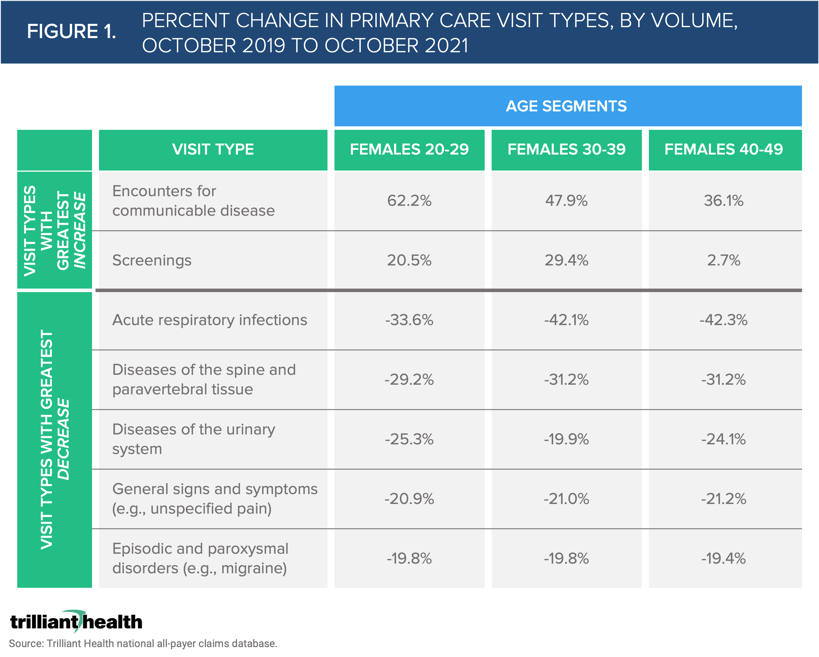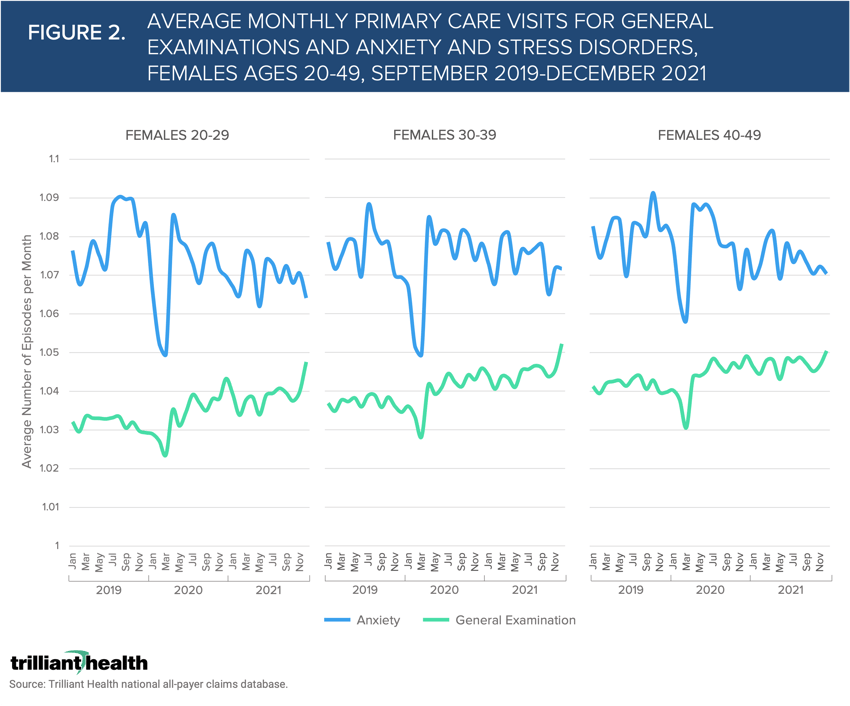The Compass
Sanjula Jain, Ph.D. | March 27, 2022Increase in Primary Care Volume for Females Ages 20-49 Attributed to Preventive Screenings and COVID-19-Related Encounters
As more employers expand coverage of women’s, maternal, and family health services and investments in “FemTech” mount, insight into the primary care behaviors of the target population would better inform investments in female-focused healthcare services.
Our previous research reveals that most Americans have not "caught up" from their lack of primary care utilization during the pandemic, except females ages 20-49. In aggregate, pre-pandemic U.S. primary care utilization peaked in October 2019, and primary care volumes in October 2021 were 24% lower than the peak. In contrast, primary care volumes for females ages 20-49 in October 2021 increased by 7% from October 2019.
In light of this difference, we decided to further examine utilization by females between 20-49 at the diagnosis level. We isolated the top primary care diagnoses shared across females ages 20-29, 30-39, and 40-49 in October 2019 and October 2021, since those months showed the highest primary care volumes. The visit type with the greatest percent change across age groups is encounters for communicable diseases, likely connected to COVID-19. Visits for screenings also increased across all age groups, indicating a return to preventive care (Figure 1). Notably, visits for anxiety and stress disorders increased across age groups from October 2019 to October 2020, and then declined from October 2020 to October 2021. Of note is that the utilization of screenings was significant in the 20-29 and 30-39 cohorts, but there was almost no change among the 40-49 cohort.

Our previous research also revealed the disproportionately high utilization of telehealth within the female 20-49 cohort for behavioral health. Since many behavioral health needs present in primary care settings, we segmented our analysis by visits for routine examinations versus visits for anxiety and stress disorders to evaluate whether the increase in primary care was attributed to rebounding preventive services or growing demand for behavioral health services.
We found that average monthly routine examination visits are exceeding pre-pandemic levels across the female age cohorts between 20-49, indicating a return to certain screenings and preventive services for this population segment (Figure 2), as visits related to behavioral health have returned to pre-pandemic levels.

In contrast to the clinical complexity that will present in patients who delayed seeking care during the last two years of the pandemic, females in the 20-49 cohort are seemingly prioritizing individual health in the wake of the pandemic. Every primary care provider targeting females in the 20-49 cohort, whether “FemTech” or retailers or health systems, should focus on understanding who these patients are, why they are utilizing more primary care, and where they access it. We will begin to explore the consumer attributes and localized behaviors of these patients in subsequent research.
Thanks to Kelly Boyce and Katie Patton for their research support.
- Women's Health
- Primary Care
You are currently viewing a free preview of our premium studies. To receive new studies weekly, upgrade to Compass+ Professional.
Sign UpSee more with Compass+
You are currently viewing the free version of this study. To access the full study, subscribe to Compass+ Professional for $199 per year.
Sign Up for Compass+